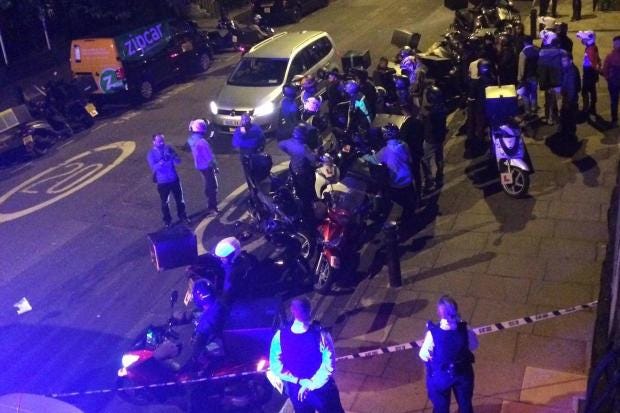Steve Balich Editors note:
England is what liberals must view as Utopia except there is always a weapon.
Selling, buying and carrying knives
The maximum penalty for an adult carrying a knife is 4 years in prison and an unlimited fine. You’ll get a prison sentence if you’re convicted of carrying a knife more than once.
Basic laws on knives
It is illegal to:
- sell a knife to anyone under 18 (16 to 18 year olds in Scotland can buy cutlery and kitchen knives) unless it’s a knife with a folding blade 3 inches long (7.62cm) or less
- carry a knife in public without good reason - unless it’s a knife with a folding blade 3 inches long (7.62cm) or less
- carry, buy or sell any type of banned knife
- use any knife in a threatening way (even a legal knife)
Lock knives are not classed as folding knives and are illegal to carry in public without good reason. Lock knives:
- have blades that can be locked and refolded only by pressing a button
- can include multi-tool knives - tools that also contain other devices such as a screwdriver or can opener
Banned knives and weapons
It is illegal to bring into the UK, sell, hire, lend or give anyone the following:
- butterfly knives (also known as ‘balisongs’) - a blade hidden inside a handle that splits in the middle
- disguised knives - a blade or sharp point hidden inside what looks like everyday objects such as a buckle, phone, brush or lipstick
- flick knives (also known as ‘switchblades’ or ‘automatic knives’) - a blade hidden inside a handle which shoots out when a button is pressed
- gravity knives
- stealth knives - a knife or spike not made from metal (except when used at home, for food or a toy)
- zombie knives - a knife with a cutting edge, a serrated edge and images or words suggesting it is used for violence
- swords, including samurai swords - a curved blade over 50cm (with some exceptions, such as antiques and swords made to traditional methods before 1954)
- sword-sticks - a hollow walking stick or cane containing a blade
- push daggers
- blowpipes (‘blow gun’)
- telescopic truncheons - extend automatically by pressing button or spring in the handle
- batons - straight, side-handled or friction-lock truncheons
- hollow kubotans - a cylinder-shaped keychain holding spikes
- shurikens (also known as ‘shaken’, ‘death stars’ or ‘throwing stars’)
- kusari-gama - a sickle attached to a rope, cord or wire
- kyoketsu-shoge - a hook-knife attached to a rope, cord or wire
- kusari (or ‘manrikigusari’) - a weight attached to a rope, cord, wire
- hand or foot-claws
- knuckledusters
Contact your local police to check if a knife or weapon is illegal.
Good reasons for carrying a knife or weapon
Examples of good reasons to carry a knife or weapon in public can include:
- taking knives you use at work to and from work
- taking it to a gallery or museum to be exhibited
- if it’ll be used for theatre, film, television, historical reenactment or religious purposes, for example the kirpan some Sikhs carry
- if it’ll be used in a demonstration or to teach someone how to use it
A court will decide if you’ve got a good reason to carry a knife or a weapon if you’re charged with carrying it illegally.
Last updated: 3 March 2017
Guns and firearms
You need a firearms certificate issued by the police to possess, buy or acquire a firearm or shotgun. You must also have a certificate to buy ammunition. It is illegal for anyone aged under 18 to purchase an imitation firearm and for anyone to sell an imitation firearm to someone aged under 18.
Certain firearms are completely prohibited. You won’t be able to get a certificate for them and it is an offence to possess, buy or acquire them without the authority of the Home Secretary.
It is an offence to be in possession of a firearm, a shotgun or dangerous air-weapon and certain ammunition without a certificate or to be in possession of a prohibited weapon.
Carrying a weapon
If you are caught illegally carrying a knife or a gun, even an imitation one you will be arrested and prosecuted. It is no excuse to say it was for your own protection or you were carrying it for someone else.
Remember - the law is clear - if you choose to carry a weapon, you put your future in danger. If you don't take it with you, it won't be used.
Play your part in reducing knife and gun crime by reporting people you know or suspect may be carrying a weapon illegally.
Call your local police on 101, or dial 999 if a crime is in progress or a life is in danger.
If you can't talk to police, contact the independent charity Crimestoppers by calling 0800 555 111 or using their online reporting form(opens in a new window) and give information about crime anonymously.
Section 139 of the Criminal Justice Act 1988 makes it an offence to have "any article which has a blade or is sharply pointed" in a public place. The only type of knife that is excluded from this definition is a "folding pocketknife", a penknife in normal parlance, with a blade of three inches or less. But the courts have held that this exclusion does not extend to a knife whose blade can be locked open (a lock knife); it would be an offence to carry one of these, however long the blade.
The courts have convicted someone for carrying a butter knife, but decided in another case that a screwdriver does not fall foul of this law. A screwdriver might, however, be considered an offensive weapon – I'll come to those later.
What is a public place is fairly obvious; it includes any place to which the public generally has access, including on payment of an entry fee, so for example a football ground.
A separate section, section 139A of the same act, makes it an offence to have a knife or article to which section 139 applies in school premises.
Both sections 139 and 139A provide defences to people charged with these offences. It is a defence to show that you had the knife or bladed or pointed article for use at work, for religious reasons (eg the Sikh kirpan), as part of a national costume (eg the sgian dubh of traditional Highland dress) or, in respect of the schools offence, for educational reasons. More broadly, you can defend the charge on the grounds that you had "good reason or lawful authority" for having the item with you. Lawful authority would cover, say, where a police officer has seized a knife in a search and is carrying it back to the police station. If you buy a kitchen knife and are stopped carrying it home a court would doubtless consider that you had a good reason for having it on you at that time. But if you forget to take it out of your bag and are caught with it in a public place on a subsequent occasion, you won't have a defence. Forgetfulness on its own is not a good reason.
If convicted of either offence you could be sent to prison for up to four years if your case is dealt with in the crown court (six months if you are sentenced by magistrates) or fined. Of course, people hardly ever get the maximum sentence for an offence but shortish prison sentences are not unusual for these offences.
It is not only knifes and bladed or pointed articles that you can be done for. A separate statute, the Prevention of Crime Act 1953, makes it an offence to have an offensive weapon in a public place.
The courts have held that there are three types of offensive weapon: items that were clearly produced for use as weapons (eg knuckle-dusters, truncheons, flick knives, butterfly knives), items that have been adapted in some way for use as a weapon (eg a bottle broken deliberately to be used as a weapon), and items that usually have an innocent purpose but are being carried with the intention of causing injury to others. Lots of items could come within this category – and it could include a penknife that wouldn't come within section 139 – but in order to get a conviction the prosecution has to prove that the defendant had the necessary intention.
Again it is a defence to show that you had lawful authority to be carrying the item. So police officers won't get into trouble for carrying their truncheons. There is also a defence of "reasonable excuse". The courts have held that this could extend to circumstances where you arm yourself with something in response to a threat of imminent attack.
Searches
Under section 1 of the Police and Criminal Evidence Act 1984 police officers are allowed to search people or vehicles for offensive weapons or items to which section 139 Criminal Justice Act 1988 applies (among other things) if they have reasonable grounds for suspecting that they will find the relevant items. Of course, an officer might decide to conduct a search looking for one thing, stolen goods perhaps, and then find a knife in the course of the search; that would not make the search unlawful.
Shadowfirebird asks whether there are things other than knives that a police officer might be interested in if s/he finds them in the course of a search. Given what I have said about innocent items that could be used as weapons, there are lots of things that could arouse an officer's suspicion. Of course, an officer finding such an innocent but potentially lethal item is unlikely to query it unless there is some indication that the person searched is carrying it with the intention to cause injury to others. As for knives (other than penknives), which are all potentially unlawful if carried in a public place, I would hope that officers won't take action where it is clear that one of the defences to the charge under section 139 is made out. So if an officer stops someone and finds a kitchen knife with its receipt in a John Lewis bag there is no reason in the absence of some other circumstance to arrest the person or seize the knife.
Acid to be defined as 'highly dangerous weapon' for first time to impose tougher prison sentences
Adults caught carrying acid twice or using it to threaten someone will be jailed for a minimum of six months






No comments:
Post a Comment